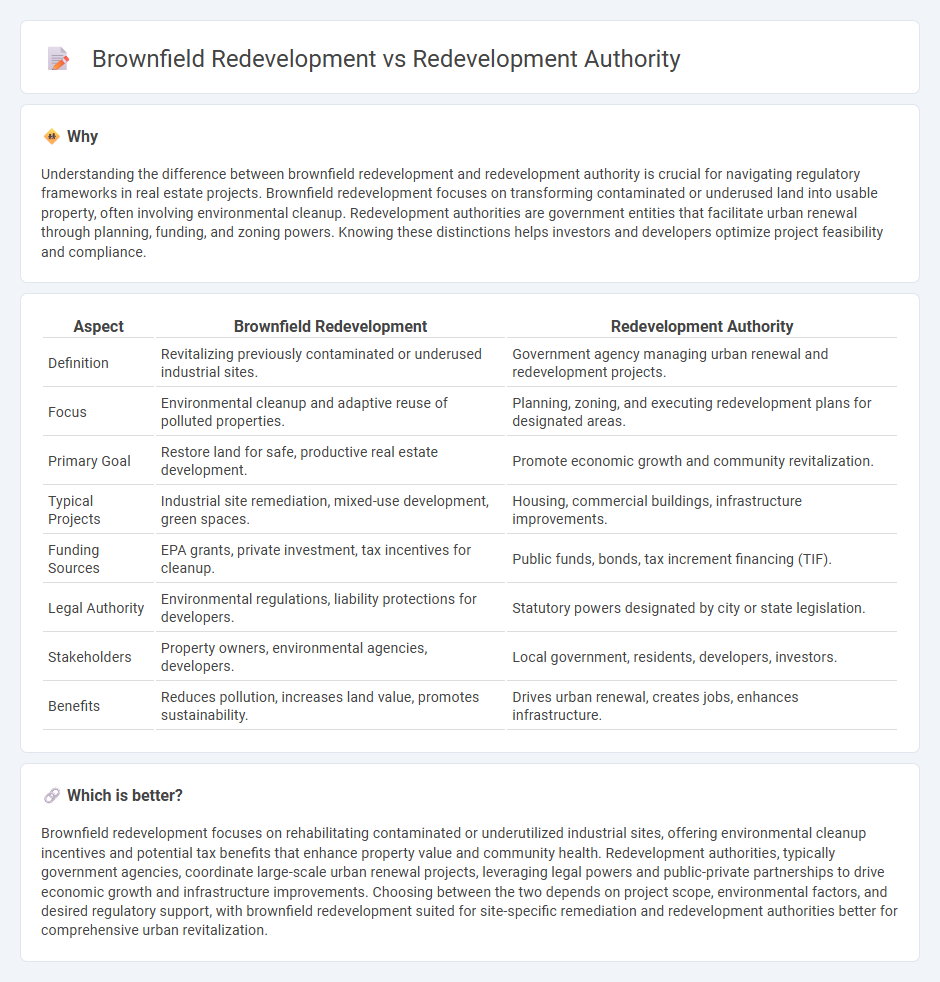
Brownfield redevelopment involves transforming previously contaminated or underutilized industrial sites into valuable real estate assets, often requiring environmental cleanup and strategic investment. Redevelopment Authorities are specialized government entities that facilitate urban renewal projects by providing funding, regulatory support, and tax incentives to stimulate economic growth and community revitalization. Explore how these frameworks drive sustainable real estate development and maximize property value.
Why it is important
Understanding the difference between brownfield redevelopment and redevelopment authority is crucial for navigating regulatory frameworks in real estate projects. Brownfield redevelopment focuses on transforming contaminated or underused land into usable property, often involving environmental cleanup. Redevelopment authorities are government entities that facilitate urban renewal through planning, funding, and zoning powers. Knowing these distinctions helps investors and developers optimize project feasibility and compliance.
Comparison Table
| Aspect | Brownfield Redevelopment | Redevelopment Authority |
|---|---|---|
| Definition | Revitalizing previously contaminated or underused industrial sites. | Government agency managing urban renewal and redevelopment projects. |
| Focus | Environmental cleanup and adaptive reuse of polluted properties. | Planning, zoning, and executing redevelopment plans for designated areas. |
| Primary Goal | Restore land for safe, productive real estate development. | Promote economic growth and community revitalization. |
| Typical Projects | Industrial site remediation, mixed-use development, green spaces. | Housing, commercial buildings, infrastructure improvements. |
| Funding Sources | EPA grants, private investment, tax incentives for cleanup. | Public funds, bonds, tax increment financing (TIF). |
| Legal Authority | Environmental regulations, liability protections for developers. | Statutory powers designated by city or state legislation. |
| Stakeholders | Property owners, environmental agencies, developers. | Local government, residents, developers, investors. |
| Benefits | Reduces pollution, increases land value, promotes sustainability. | Drives urban renewal, creates jobs, enhances infrastructure. |
Which is better?
Brownfield redevelopment focuses on rehabilitating contaminated or underutilized industrial sites, offering environmental cleanup incentives and potential tax benefits that enhance property value and community health. Redevelopment authorities, typically government agencies, coordinate large-scale urban renewal projects, leveraging legal powers and public-private partnerships to drive economic growth and infrastructure improvements. Choosing between the two depends on project scope, environmental factors, and desired regulatory support, with brownfield redevelopment suited for site-specific remediation and redevelopment authorities better for comprehensive urban revitalization.
Connection
Brownfield redevelopment transforms contaminated or underutilized urban sites into viable real estate assets, enhancing property values and community development. Redevelopment authorities play a crucial role by providing regulatory oversight, funding incentives, and coordination with environmental agencies to facilitate these projects. Their collaboration accelerates site cleanup and reuse, driving sustainable urban revitalization and economic growth.
Key Terms
Eminent Domain
Redevelopment authorities hold statutory power to use eminent domain for revitalizing blighted urban areas, enabling land acquisition for public projects that stimulate economic growth. Brownfield redevelopment focuses on cleaning and repurposing contaminated properties, often requiring collaboration between private developers and public agencies to manage environmental remediation and land acquisition, which may involve eminent domain in complex cases. Explore deeper insights into how eminent domain influences urban revitalization strategies and property rights.
Environmental Remediation
A Redevelopment Authority typically oversees the planning and execution of urban renewal projects, including environmental remediation to address contamination on underutilized or blighted sites. Brownfield Redevelopment specifically targets properties complicated by hazardous substances, pollutants, or contaminants, requiring thorough environmental assessment and cleanup before reuse. Explore the distinct roles and processes involved in these frameworks to understand effective environmental remediation strategies.
Tax Increment Financing (TIF)
Redevelopment authorities are government bodies designated to oversee urban renewal projects, often utilizing Tax Increment Financing (TIF) as a key funding mechanism to stimulate economic growth and infrastructure improvements within designated areas. Brownfield redevelopment specifically targets the cleanup and reuse of contaminated or underutilized properties, leveraging TIF to attract private investment by capturing increased tax revenues from rehabilitated sites. Explore how these two approaches utilize TIF to transform urban landscapes and drive sustainable community development.
Source and External Links
Redevelopment Authority | City of Lancaster, PA - The Redevelopment Authority of Lancaster City focuses on redeveloping blighted areas and providing affordable housing and commercial spaces through rehabilitation efforts.
About RDA - The Prince George's County Redevelopment Authority aims to revitalize communities, especially near transit centers, by acquiring and developing vacant properties to enhance quality of life and economic growth.
Community Redevelopment Authority | Laurel, MD - The Community Redevelopment Authority in Laurel, MD, works to build strong communities by supporting projects that enhance growth, job creation, and quality of life through revitalization efforts.
 dowidth.com
dowidth.com